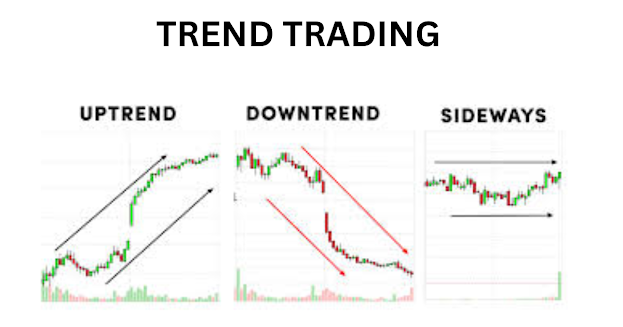Trend Trading : How to Identify and Follow Market Trends for Profitable Trading
Trend trading is a popular trading strategy that involves identifying and following trends in the financial markets. By identifying trends and trading in the direction of the trend, traders can potentially capture profits from sustained price movements. In this article, we'll explore the basics of trend trading, including how to identify trends, key strategies for following trends, and tips for successful trend trading.
What is Trend Trading?
Trend trading is a strategy that involves following market trends to identify profitable trading opportunities. Traders using this strategy seek to capitalize on sustained price movements in the direction of the trend, buying when the market is in an uptrend and selling when the market is in a downtrend.
The idea behind trend trading is that markets tend to move in trends, with periods of price increases (uptrends) and price decreases (downtrends). By identifying and trading in the direction of the trend, traders can potentially capture profits from these price movements.
Identifying Trends
The first step in trend trading is identifying the trend. There are several ways to do this, but one of the most common is to use technical analysis. Technical analysis involves analyzing charts and price patterns to identify trends and potential trading opportunities.
Some key indicators to watch when identifying trends include moving averages, trendlines, and chart patterns. Moving averages can help identify the direction of the trend, while trendlines and chart patterns can help traders identify key levels of support and resistance.
Following Trends
Once the trend has been identified, the next step is to follow it. There are several strategies for following trends, including:
Buy the dips: In an uptrend, traders can look for opportunities to buy on pullbacks or dips in the market.
Sell the rallies: In a downtrend, traders can look for opportunities to sell on rallies or bounces in the market.
Use trailing stops: Trailing stops can help traders protect their profits while allowing them to stay in the trade as long as the trend continues.
Use trend indicators: Trend indicators, such as the Moving Average Convergence Divergence (MACD) or the Relative Strength Index (RSI), can help traders identify when a trend is beginning to weaken or reverse.
Tips for Successful Trend Trading
Here are some tips to help you succeed in trend trading:
Stick to the trend: Don't try to fight the trend. Stay disciplined and trade in the direction of the trend.
Use stop-loss orders: Always use stop-loss orders to limit your losses if the market moves against you.
Practice proper risk management: Position sizing and leverage management are critical for managing risk in trend trading.
Stay informed: Stay up-to-date on market news and economic events that may affect the trend.
Be patient: Trend trading requires patience and discipline. Don't try to force trades if there are no clear opportunities.
Specifically, trend trading is a popular strategy in various financial markets, including stocks, commodities, and currencies. It is often used by long-term investors who seek to take advantage of major market trends over an extended period. However, trend trading can also be effective for short-term traders who look for quick opportunities within shorter-term trends.
One of the key advantages of trend trading is that it takes advantage of the momentum of the market. When a market is trending strongly, it tends to continue in that direction for a significant period. By trading in the direction of the trend, traders can potentially capture profits from these sustained price movements.
However, one of the challenges of trend trading is that it requires patience and discipline. Trends can take a long time to develop and may go through periods of consolidation or reversal. Traders need to be able to identify when a trend is beginning to weaken or reverse and be prepared to exit the trade to avoid significant losses.
Another important consideration when trend trading is risk management. Position sizing, leverage management, and the use of stop-loss orders can help traders manage their risk exposure and avoid significant losses. It's also important to remember that not all trades will be profitable, and traders should have a plan in place to manage losses and keep them under control.
Conclusion
Trend trading can be a profitable trading strategy for experienced traders who are able to identify and follow trends in the financial markets. By using technical analysis, following key indicators, and employing proper risk management, traders can potentially capture profits from sustained price movements. However, it's important to remember that trend trading is not without risk, and traders must be disciplined and patient in order to succeed.





No comments:
Post a Comment